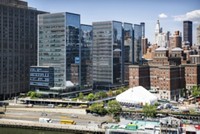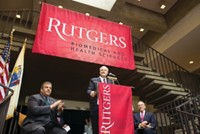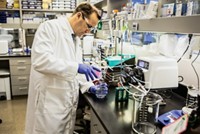Advertisement
Grab your lab coat. Let's get started
Welcome!
Welcome!
Create an account below to get 6 C&EN articles per month, receive newsletters and more - all free.
It seems this is your first time logging in online. Please enter the following information to continue.
As an ACS member you automatically get access to this site. All we need is few more details to create your reading experience.
Not you? Sign in with a different account.
Not you? Sign in with a different account.
ERROR 1
ERROR 1
ERROR 2
ERROR 2
ERROR 2
ERROR 2
ERROR 2
Password and Confirm password must match.
If you have an ACS member number, please enter it here so we can link this account to your membership. (optional)
ERROR 2
ACS values your privacy. By submitting your information, you are gaining access to C&EN and subscribing to our weekly newsletter. We use the information you provide to make your reading experience better, and we will never sell your data to third party members.
Pharmaceuticals
Big Pharma Comes To Town
When in Cambridge, major drug companies play by Cambridge rules in a quest for breakthroughs
by Rick Mullin
May 3, 2010
| A version of this story appeared in
Volume 88, Issue 18

Cambridge, Mass., has always been a diverse community. It’s at once the “fair city” of Tom and Ray Magliozzi, the regular-guy hosts of “Car Talk” on National Public Radio, and an elite academic haven where the red brick and ivy of Harvard University coexist with the modern architectural sprawl of Massachusetts Institute of Technology.
Since the 1980s, the area’s mix of academia and medical institutions, including Massachusetts General Hospital and the Broad Institute, has created a breeding ground for biopharmaceutical companies. Industry leaders Genzyme, Biogen Idec, and Millennium Pharmaceuticals settled among the schools and old manufacturing buildings throughout the city.
More recently, Pfizer and Novartis bought an old Model-A Ford tire plant and a New England Confectionery Co. candy factory, respectively. Merck & Co. set up labs across the river in Boston, AstraZeneca moved to nearby Waltham, and Wyeth purchased Genetics Institute, which had built a sizable research campus in the north end of Cambridge. Last year, Pfizer purchased Wyeth, more than doubling its presence in the region.
Big pharma came to the Boston area the way it does most things—en masse. The reason is clear. Drug firms wanted to hook into innovative, risk-taking research at the frontier of science. Big drug companies have also invested in West Coast research operations, acquiring biotech firms in San Diego and the Bay Area, but the industry is clearly concentrating its efforts in Cambridge. Novartis, in fact, has established Cambridge as its worldwide headquarters for drug discovery research.
Although the strategy makes perfect sense, success is far from ensured. Given its tradition of centralized research focused on blockbuster drugs, big pharma is the cultural antithesis to the free-flowing academic world of Cambridge. By all accounts, however, the new neighbors not only fit in nicely but have actually accelerated the pace of Cambridge-style R&D with a cross-pollination of academic and commercial research.
Some see big pharma’s arrival in Cambridge as testimony to the headway drug firms have made in breaking up research into smaller, self-directed units focused on specific diseases. Others point to the strides academic researchers have made in embracing corporate ways—as illustrated by the number of them starting small companies. These trends are enhanced by what has always been Cambridge’s greatest asset for business—its talent pool. It’s a pool that has grown increasingly agnostic in how it aligns with academia and industry, biology and chemistry.
Peter Abair, director of economic development at the Massachusetts Biotechnology Council, has watched the change. “Ten years ago, industry here meant the biotech industry. Now, it’s the biopharma industry.” Lines have blurred, he says. “We don’t use the term ‘big pharma’ anymore. It’s ‘big biopharma.’ Novartis and Pfizer, AstraZeneca and Merck have become part of this community in a way we wouldn’t have foreseen even four years ago,” Abair adds.
Despite some real changes in approach, however, significant new drugs have yet to emerge from big pharma’s Cambridge operations. And with Pfizer and Merck linking their own Boston-area operations with those of their recent acquisitions—Wyeth and Schering-Plough—there is the question of whether major pharmaceutical companies’ presence in town will overwhelm the local culture.
Timothy J. McDermott is senior director of operations at Pfizer Cambridge North, the former Wyeth campus, and has worked at the site since 2003. He thinks it is more likely that Cambridge will put its stamp on big pharma research than vice versa.
“Cambridge will not let you act like big pharma,” he says. “You’re encouraged to have a campus here. But they won’t let you put up a fence.” The culture centers on innovation, McDermott says, but also on risk-taking, which is not the research tradition at many big drug companies. “Cambridge is so well established as nonconformist that you couldn’t change it,” he says. “People call it the People’s Republic of Cambridge—it’s a hotbed for free thought.”
At Wyeth, the Cambridge environment spawned a multidisciplinary research culture, with chemists and biologists working in a collaborative environment. The culture is also the basis for partnerships with local academic and biotech researchers, something Pfizer hopes to accelerate “in a serious way,” McDermott says.
Pfizer came to Cambridge 11 years ago, establishing what it called its Research Technology Center at the old tire factory on the Charles River, close to MIT. “This was before the Warner-Lambert and Pharmacia acquisitions, and Pfizer was looking to grow,” recalls John McNeish, the firm’s executive director of regenerative medicine.
The company was interested in solidifying its molecular biology research. It would concentrate on new science that was separate, at least physically, from central research and near top-flight institutions. “The thinking was already starting to evolve to where you didn’t have to internalize everything,” McNeish says.
Stem cell research is a good example of a technology that would likely advance in Cambridge, he says. “If you have access to academic expertise that you can merge with your own drug discovery expertise, then you can really get a strong return on that investment,” he adds.

Pfizer made significant progress on stem cells, McNeish says, moving beyond the initial intent to employ the technology in the production of knock-out mice to using it in high-throughput in vitro drug screening by differentiating stem cells into clinically relevant cell types. But the Cambridge center’s focus soon shifted to something more like business as usual at big pharma, he acknowledges.
“After the Warner-Lambert merger, our mission changed to chemical-screening technology,” he says. “We didn’t rely as much on the Boston and Cambridge culture for molecular biology anymore. We were working with instrumentation companies like Caliper and doing less work with academics.”
About four years ago, however, the focus shifted from chemistry back to biology and informatics, McNeish explains, as compound-library screening took a backseat in the drug industry to biology-oriented research. “Now this building is almost 100% a biology building,” he says, referring to the Research Technology Center. “There are chemistry labs here, but a lot of the chemistry has moved. It is in a supporting role, not a leading role, here.”
McNeish came to Cambridge in 2008 after working at Pfizer’s giant research hub in Groton, Conn., for 16 years. As such, he is aware of the cultural gap between corporate research and the laboratories that make up what is now called Pfizer Cambridge South. “I am doing my damnedest to close that gap,” he says, with the aim of increasing collaboration and eliminating redundancies.
McNeish, however, is not looking to homogenize research in the process. “The challenge is in being able to keep this area more contiguous with Groton without the Groton mode being superimposed,” he says. Yet he doesn’t think he could break the local research culture even if he tried.
In fact, McNeish argues that Pfizer’s Cambridge researchers have a lot in common with those at the small biotech firms that the company has acquired in recent years. He notes that Pfizer’s RNA interference research was born of its 2007 acquisition of Coley Pharmaceutical, in Wellesley, Mass. Although Coley was folded into Pfizer, the RNAi researchers work in much the same way as they always did, he says.
McNeish laughs when asked if Pfizer’s next breakthrough will occur in Cambridge. “Yes,” he proclaims with mock certainty. “I think Pfizer believes this is the front line in its biotech and biotherapy focus,” he adds, pointing to the big biotech boost that came from the Wyeth acquisition. Wyeth also brought vaccines. Ninety-five percent of Pfizer’s staff in Cambridge is now working in biotherapeutics, he says.
And a breakthrough could be significant, according to McNeish, who does not back off from the idea of aiming for a blockbuster. “There are blockbuster vaccines, antibodies, biologics, and regenerative medicines. We are all just trying to find the next EPO for metabolic disease,” he says, referring to erythropoietin, a blockbuster biologic drug. “In some areas there are intractable diseases that could never be treated with a small molecule. Cells and biologics open up brand-new doors,” he adds.

Novartis moved to Cambridge in 2002 with the intent of forging a new approach to drug discovery. The company established the Novartis Institutes for BioMedical Research (NIBR) as the global headquarters of its drug discovery efforts, shifting the emphasis from its laboratories in East Hanover, N.J., to the renovated candy factory in Cambridge. Mark Fishman, a physician and former Harvard Medical School professor, signed on as president and launched a research program that refocused R&D at Novartis on scientifically tractable disease mechanisms.
Scott Biller, head of global discovery chemistry at NIBR, maintains that the relocation of the R&D headquarters makes sense. “Important things happen at all our research sites, but there are a lot of opportunities here,” he says. Links can be made to the academic community and to clinical research. “There is a major advantage to being close to hospitals and clinical investigators,” he says. Those are “things you don’t get in a suburban campus,” he adds.
NIBR, according to Biller, emerged from former chief executive officer Daniel Vasella’s strategy for continuing the growth that followed the 1996 merger of Ciba-Geigy and Sandoz. “He believed that what the company needed in order to take it to the next level was to integrate the headquarters into a broader research community,” Biller says.
Fishman’s outsider perspective—that of a patient-oriented physician—has been a catalyst for drug discovery at NIBR, Biller says. The local academic and institutional science, small biotech companies, and talented workforce mesh with Fishman’s perspective to make for an interdisciplinary research environment, he adds.
Brian Jones, NIBR’s head of discovery chemistry in Cambridge, cautions not to put too much importance on the location. “If you get it in your mind that Cambridge is more important than other research locations, you go against the purpose of being here, which is to increase the global impact of research,” say Jones, who came to Novartis from Merck in 2006. “The last thing we want to do is constrain or narrow that impact.”
The company has entered several ventures with local academic and medical organizations, signing, for example, a research partnership with the Harvard Stem Cell Institute focused on small molecules that affect neuromuscular disorders. Novartis has also signed on with the Broad Institute to decipher the genetic causes of type 2 diabetes. The project will report its findings freely to other researchers.
Novartis has succeeded in attracting research talent to the old candy factory, inside which it has cut a gaping amoebiform hole in each of the six floors, installing tubular glass elevators to give the structure an open and transparent feel. Researchers, however, point to the company’s approach to drug discovery as the main attraction, noting that the open space reflects the environment of collaboration that melds chemistry and biology into a united scientific front.
John A. Tallarico, a former Harvard chemical biologist and now head of chemogenetics at NIBR, says he was attracted to the way Novartis channeled cutting-edge science into a commercial pharmaceutical venture. He contends that he made no scientific concessions in leaving academia. “Since joining, I’ve continued doing the same research—just with better equipment,” Tallarico says.
It’s the institute’s emphasis on risk-taking and on chemistry that is most appealing to Timothy M. Ramsey, executive director of oncology chemistry at NIBR. Lawrence Hamann, executive director of hit-to-lead optimization, agrees that chemistry is important at NIBR, but he generally downplays distinctions between disciplines. “Novartis has been successful at blurring the lines between classical chemistry and biology,” he says. “We are using chemistry to answer biological questions and vice versa.”
The theme of interdisciplinary science resonates throughout the Cambridge research community. The overriding theme, however, is one of collaboration. J. C. Gutierrez-Ramos, senior vice president of biotherapeutics R&D at Pfizer and head of the company’s Cambridge operations, sees collaboration with the academic and medical researchers in Cambridge as essential to innovation at Pfizer and other big drug companies.
Gutierrez-Ramos says that Pfizer means to leverage its growing presence in Cambridge to better access innovation from institutional laboratories. “All the way up to the CEO, there is a commitment at Pfizer to reframe the interaction with academia and biotech to allow these partnerships,” he says. “It is a matter of success. If we don’t reframe those interactions, we will not capitalize on and benefit from innovation.”
Advertisement
He agrees with McNeish that innovation will also require independent research operations with a biotech-like entrepreneurial bent. “I’d rather have a loose association of units with core values but that are very independent in how they interact with academia and other biotechs,” Gutierrez-Ramos says. “In six to eight months, I want to be able to show you a Google-like campus.”
Industry watchers acknowledge that drug companies are exhibiting new behavior in Cambridge. Timothy Coetzee, president of Fast Forward, a New York City-based research funding group focused on multiple sclerosis, sees the Boston area as an ideal setting for big pharma to achieve breakthroughs—and an ideal place in which to fail. “Cambridge has amazing minds and money,” Coetzee said. “It is the right cauldron for success and for failure because there is room to fail. There are safety nets, which supports risk‑taking.”
He is optimistic that big pharma is already building on a foundation set by academia and the biotech industry. “Big pharma won’t be going back to the big behemoths. That model is moving away because every CEO now recognizes that their company needs to evolve.”
James Mullen, CEO of Biogen Idec, is not worried that big pharma will impose its traditional research culture on his company’s hometown. “They came here to change their own culture,” he says, noting that Novartis has had more success expanding a biotech venture in Cambridge than it did in East Hanover. But he points out that culture change is not enough. “They claim they have changed, but the proof is in the products,” he says. “There haven’t been a lot of products coming from it.”
Cambridge-based researchers at Pfizer and Novartis are acutely aware that they are under pressure to introduce significant new cures. Novartis’ Biller, in discussing personalized medicine, points to the cancer treatment Gleevec as the company’s big breakthrough—albeit one that occurred before Novartis moved to town. But he and other big-pharma executives see advances in which Cambridge has played a major role. “Several compounds that came out of Cambridge have already achieved proof of concept in humans,” Biller says.
“We have never been in this situation before, where technologies to make drugs have been so advanced in small molecules, antibodies, and protein-drug conjugates,” Gutierrez-Ramos says. But the clock is running. “Society has demands,” he says. How much time does industry have to show significant new drugs? “Half a decade,” Gutierrez-Ramos answers decisively. “Five years.”






Join the conversation
Contact the reporter
Submit a Letter to the Editor for publication
Engage with us on Twitter